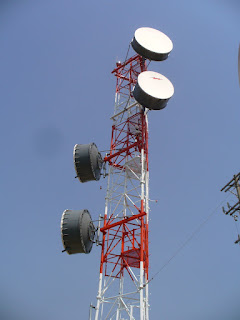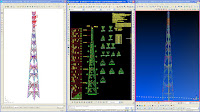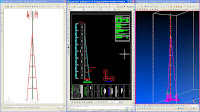Analysis and Checking of Latticed Towers & Masts
MStower V6 is a Windows program for the analysis and checking of latticed towers and masts. It is used by designers and authorities for the checking of transmission line structures and communications towers and masts.
RENDERED PLOT OF PART OF A TOWER
The program has options for the generation of geometry and loading, analysis, application of gust factors to member forces, and checking of members. There are comprehensive facilities for plotting of the structure, loading, and results. The structure geometry is specified by data describing panels, dimensions, sections, and ancillary equipment. Section properties and ancillary data are taken from standard library files. Wind and ice loads on members, antennas, and ancillaries are computed automatically.
Loads may be computed according to the rules of:
- BS 8100:Part 1:1986 (towers)
- BS8100:Part 4:1995 (guyed masts)
- ANSI EIA/TIA-222-F-1996
- AS3995-1994
- Malaysian Electricity Supply Regulations 1990
Ancillaries are shown on the screen and each may be interrogated by clicking on it.
PLOT OF PART OF TOWER WITH ANTENNAS
Tower members may be checked using the rules of:
- BS8100:Part 3:1997 (Limit state)
- BS449:1990 (Allowable stress)
- AS 3995-1994 (Limit state)
- ANSI 10-90 (Limit state)
- EIA/TIA-222-F. 1996 (Allowable stress)
Please have the original Software.
Posted from : www.mstower.com










.JPG)






px.jpg)














